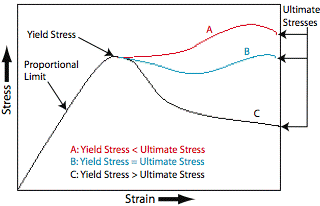Materials Links & Resources: Plastics
Types of Plastics
Plastics are organic materials made from large molecules that are constructed by a chain-like attachment of certain building block molecules. The different types of plastics can be broken up into two broad categories; thermosetting plastics and thermoplastics.
- Thermosetting plastic - A resin or plastic compound that in its final state is substantially infusible and insoluble. Once their shape has been made by casting or by plastic flow at elevated temperature they will no longer remelt or flow upon reheating. Polymerization has occurred by strong network bonds (cross-linking) produced by catalysis or by the application of heat and pressure. These strong bonds keep the material from remelting. (Budinski, 1996)
- Thermoplastic - A resin or plastic compound that, as a finished material is capable of being repeatedly softened by heating and hardened by cooling. Thermoplastics are made by applying a large amount of heat to solid forms to get them to flow and then cooling to solidify. ( Beck, 1980)
Plastics have generic names like polypropylene, but specific products go by a plethora of brand names which are neither descriptive nor related to their generic names. It is important to know that plastics data varies from manufacturer to manufacturer, from batch to batch and even within a batch. For this reason one must be conservative when designing with plastics and refer to both the manufacturer's data sheets, test methods employed and fully understand their meaning (see Dym, 1983, Ch. 2).
Some Important Fundamentals
 Plastics are unlike metals in several respects: they (1) yield below, at, or above their ultimate stress values as shown in the figure at right, (2) are affected by temperature, and (3) deform over time (they creep!) at significant rates, much faster than metals. For these reasons, in applications apply factors of safety to the lower value of yield or ultimate stress, seek expert advice for use other than at room temperature and, for modulus, use the Creep Modulus (also known as the Apparent Modulus) determined from creep data curves by specifying the duration of load (see Dym, 1983, p. 228).
Plastics are unlike metals in several respects: they (1) yield below, at, or above their ultimate stress values as shown in the figure at right, (2) are affected by temperature, and (3) deform over time (they creep!) at significant rates, much faster than metals. For these reasons, in applications apply factors of safety to the lower value of yield or ultimate stress, seek expert advice for use other than at room temperature and, for modulus, use the Creep Modulus (also known as the Apparent Modulus) determined from creep data curves by specifying the duration of load (see Dym, 1983, p. 228).
Allowable Stress Values for Design
To obtain the Allowable Stress for design, apply the design for strength factor of safety FS to a Working Stress defined as the minimum of Yield vs. Ultimate Stress divided by a material factor of safety (MFS) where 3 < MFS < 5.
Example:
Find the Allowable Stress for Polypropylene Pro-fax 6523.
Data from:
(a) Rubin (1990), Table 38.2, p. 441: Tensile Strength at Yield = 35.5 MPa = 5,150 psi
(b) Dym (1983), table on p. 173: Tensile Strength Ultimate = 5075 psi
Choose Dym's data because it is more conservative.
Working Stress = 5075/4 = 1270 psi where MFS = 4.
Allowable Stress = 1270/1.3 = 976 psi where FS = 1.3.
This allowable tensile stress is the value used in design.
This material is based upon work supported by the National Science Foundation under Grant No. 0633602. Any opinions, findings and conclusions or recomendations expressed in this material are those of the author(s) and do not necessarily reflect the views of the National Science Foundation (NSF).
© Copyright 1995-2026 — All rights reserved.
Pennsylvania State University
Department of Engineering Science and Mechanics
Send comments about this site to: webmaster@esm.psu.edu
This publication is available on alternative media on request.
